Written by: Feng Yang
Posted on: January 29, 2013 |  | 中文
| 中文
The Potala Palace
Tibet is a mysterious and faraway place in many people's minds. An atmosphere of religion shrouds the snow-covered plateau inhabited mostly by ethnic Tibetans. The atmosphere is so strong that it seems as if time and man were frozen by it.
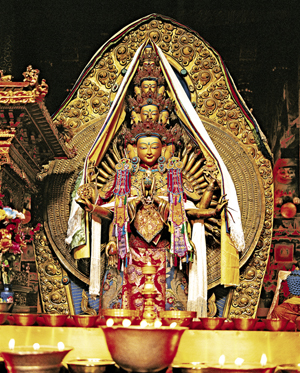 |
| Figure of Buddha in Jokhang Temple |
The Potala Palace is in Lhasa, capital of China's Tibet Autonomous Region. In the Tibetan language, the word "potala" means the "dwelling place" of Avilokiteshvara, the Buddhist Goddess of Mercy. It is where the Dalai Lamas of all generations held their political and religious activities and where they stayed when alive and after they die as well.
The Potala Palace was not originally built as a holy place for Buddhism. Songtsen Gampo (619-650), a powerful ruler of ancient Tibet and a king of the Tubo Kingdom of the time, brought all the tribes on the Qinghai-Tibet plateau under his control in the seventh century AD and established the Tubo Kingdom of his own. In 641, upon marrying Princess Wencheng of the Tang Dynasty, Songtsen Gampo decided to build a grand palace to accommodate her and to serve as a memorial to this important event. Unfortunately, the original palace was destroyed by lightning and war damage in the ninth century, when the Tubo kingdom was split.
In the year 1645, the central government officially appointed the Fifth Dalai Lama as the political and religious chief of the Tibetan local government. He then started to reconstruct the Potala Palace. The Potrang Karpo, or White Palace, was completed three years later. Construction of the Potrang Marpo, or Red Palace, was started in 1690 in memory of the Fifth Dalai Lama and to accommodate the stupa where his remains were kept for worshiping. The project was completed four years later. Some renovations in the later period extended the palace to its present size.
The Potala Palace is perched upon Marpo Ri hill - in fact it occupies almost the entire hill. Looked at from afar, the color of red alternates with that of white on the palace walls, while the golden roof is grand and splendid. The palace looks like a Tibetan castle with exterior structures of wood and stone, while the roof assumes the style of a typical Han palace. Both the exterior and interior decorations are in the style similar to that of Nepalese palaces and temples.
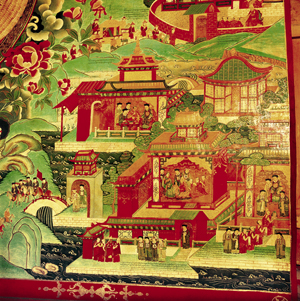 |
| Fresco inside Linta Hall |
The structure of the Potala Palace is beyond the imagination of many. It is 115 meters in height. It looks as if it has 13 storeys, but in fact it has just nine. The wall is eight meters thick and becomes gradually thinner at top, where it is only one meter thick. Molten iron was injected into some part of the walls, making them invulnerable. Looking down from atop the palace, you can see a city crowded with low Buddhist dwellings, civilian houses and workshops. There is striking contrast between the different parts of its inner structure: the halls are quite spacious while the windows are extremely narrow, and the walls are rather thick while the corridors are very narrow. All these seem to manifest the mighty power of the Buddhist doctrine and the solemnity of the Buddhist world.
The Potala Palace is composed of two parts. The Red Palace lies at its center, and the White Palace fans to the east and west. The entire structure has more than 2,000 rooms. The White Palace is seven storeys high and is where the Dalai Lamas of all generations lived and exercised their political power. The largest room is the Eastern Hall on the fourth floor, and it was here that the Dalai Lamas were enthroned and from where they ruled Tibet. The Chamber of Sunshine on the top floor is divided into the Eastern Chamber of Sunshine and the Western Chamber of Sunshine, and it lets sunlight in all day long. It is where the Dalai Lama stayed in winter. The Chamber of Sunshine has guest rooms, rest rooms and rooms where the Dalai Lamas practice Buddhist scriptures. The old rules stipulated that only Buddhist monks above the fourth rank could enter the Western Chamber of Sunshine.
The Red Palace, which is composed of several halls, is the highest complex in the Potala Palace, where the holy stupas of successive Dalai Lamas are worshiped. Among the eight holy stupas, the one that holds the remains of the Fifth Dalai Lama lies in the middle, and is the largest and most splendid. It is 14.85 meters in height and the whole tower is decorated with gold weighing 110,000 ounces in total; in addition, it has more than 10,000 diamonds, pearls and jade pieces embedded on it. The other stupas are also decorated with gold, diamonds, pearls and jade pieces. Therefore, they are extremely valuable.
The portrait of Emperor Qianlong of the Qing Dynasty (1644-1911) and his memorial tablet are placed in the highest hall of the Red Palace for people to pay tribute to. Written on the tablet, in the Chinese, Manchu, Tibetan and Mongolian languages, are the words "Long live our emperor." Starting with the Seventh Dalai Lama, Dalai Lamas of each generation would come here on January 1 (of the Tibetan calendar) to pay tribute to the portrait and memorial tablet.
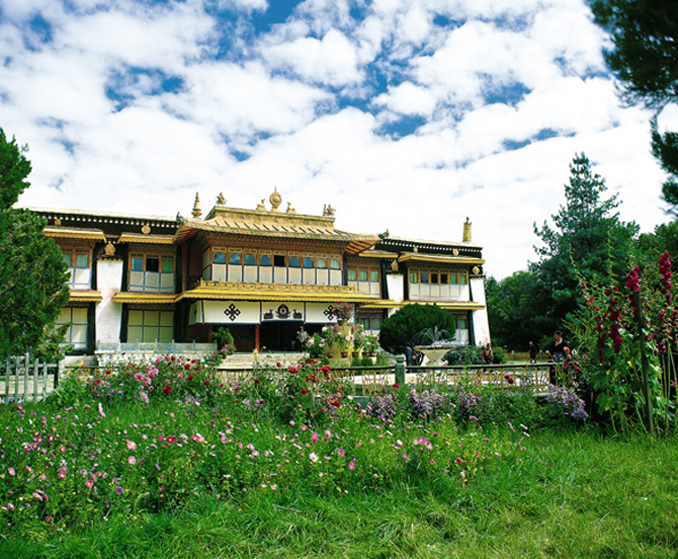 |
| Norbulingka - Summer Palace |
 |
| Red Palace |
At the back of the hill is the back garden of the Potala Palace, which is known as the Pond of the Dragon King. In the middle of the garden there is a lake, on which there are small islands. At the foot of the hill is a scenic spot called "snow", where the printing house that prints Buddhist scriptures is located along with other workshops. Located around the foot of the hill are the walls and blockhouses guarding the palace.
The Potala Palace was inscribed on the list of World Cultural Heritage in 1994. As extended items, the Jokhang Temple and Norbulingka were inscribed on the list in November 2000 and December 2001, respectively.
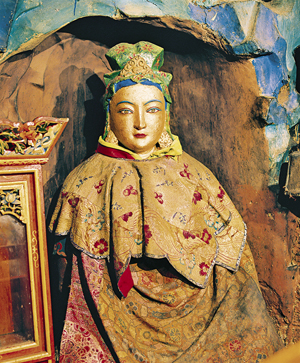 |
| Statue of Princess Wen Cheng |
Located in the center of Lhasa, the Jokhang Temple is the holiest shrine for the Tibetan school of Buddhism. It is also the largest, able to accommodate tens of thousands of lamas to conduct religious ceremonies. The temple was built in 647 AD after Songtsen Gampo married Nepalese Princess Tritsun and Princess Wencheng. Both princesses had brought Buddhist scriptures and Buddha statues, and the temple was built just to accommodate these scriptures and statues for people to pay tribute to. At that time, the temple was not as big as it is now and it had only eight halls. Several renovations have expanded the temple to its present size.
Jokhang Temple occupies a space of 25,000 square meters and has more than 20 halls. The main hall in the center has four storeys, and accommodates a gold-plated statue of Sakyamuni, the founder of Buddhism, which was brought to Tibet by Princess Wencheng. Four statues of strongmen stand on the two sides, which are "dressed" in the style of the Han Chinese of the Tang Dynasty. These statues were made to remember those who transported the statue of Sakyamuni from the Chinese capital to Tibet, according to historical records. Murals are painted on the four walls, including those depicting Princess Wencheng's arrival in Tibet and those relating the construction of the temple.
In front of the temple is a three-meter high monument to commemorate the friendship between Tibet and the Tang Dynasty. Erected in 823 AD, the monument has inscriptions describing how the princess of the Tang Dynasty was married to the King of Tubo to cement the friendship.
Norbulingka, which means "Jeweled Garden" in the Tibetan language, lies in suburban Lhasa, about three kilometers to the west of the city center. Built in 1755, Norbulingka occupies an area of 360,000 square meters and is divided into three parts: the front park in the east, the central part composed of palaces, and the forest in the west.
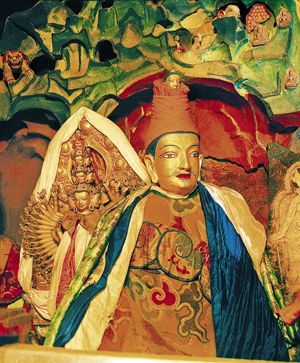 |
| Statue of Songstan Gampo |
From the 17th century onwards, the Dalai Lamas of consecutive generations would handle their political affairs and hold rituals and ceremonies in the park. They would spend summer here, arriving in March every year and returning to the Potala Palace at the end of October. Therefore, Norbulingka is also called "the Summer Palace" while the Potala Palace is known as "the Winter Place." The boy chosen as the incarnation of the Dalai Lama who had passed away, would be obliged to stay here to study Buddhist scriptures until he was old enough to be enthroned as the Dalai Lama of the next generation.
The UNESCO World Heritage Committee commented in its report: “The Jokhang Temple and Potala Palace remain, to the present day, one of the most typical areas of the country in terms of their ancient buildings and their role as the political, economic, cultural, and religious center of Tibet. The Jokhang Temple is an exceptional Buddhist religious complex. Norbulingka is a masterpiece of Tibetan art. The beauty and originality of the architecture of these three sites, their ornamentation and harmonious integration in a striking landscape, add to their historic and religious interest.”
You may also like: